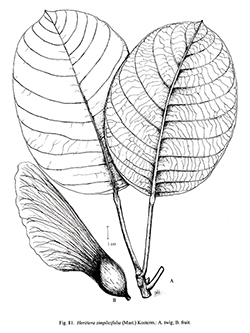e-Flora of Thailand
Volume 7 > Part 3 > Year 2001 > Page 581 > Sterculiaceae > Heritiera
6. Heritiera simplicifolia (Mast.) Kosterm.wfo-0000720335
Reinwardtia 4: 514. 1959.— Tarrietia simplicifolia Mast. in Fl. Brit. Ind. 1: 362. 1874; Ridl., Fl. Malay Penins. 1: 278. 1922. Fig. 81.
Accepted Name : This is currently accepted.
Synonyms & Citations :
Description : Tree, 20–30 m high; buttresses up to 3 m from ground; bark greyish-brown, peeling off in strips; sapwood yellowish, heartwood reddish brown; twigs stout, glabrescent, with leaf scars. Leaves simple, alternate to spiral, elliptic to broadly elliptical, 13–20 x 7–13 cm, apex broadly acute, base obtuse, glabrescent, coriaceous and coppery when dry; secondary nerves depressed on upper surface and prominent on lower surface. Petioles 5–8 cm long, glabrescent, swollen at both ends. Inflorescence axillary, paniculate up to 10 cm long, hairy then glabrescent. Sepals 5, dark red, urceolate, 1.5–2 mm long, divided one third to a half of their length, hairy on both sides. Stamens 8–10, sessile, on top of a stout and pyramidal column. Ovary in female flowers ellipsoid; one locular and one ovululate, surrounded with staminodes. Samara ellipsoid, 2.5–3 x 1.5–2 cm with a spathulate wing, ca 10 x 4 cm; sparsely hairy then glabrescent.
Thailand : NORTHERN: Phrae.
Distribution : Malay Peninsula (type), Indonesia, the Philippines.
Ecology : In evergreen forests, on well drained soil, 800–1,000 m alt. Flowering and fruiting: December–April.
Vernacular : Chum phraek khao (ชุมแพรกเขา)(Northern).
Uses: Wood is very durable, used for furniture, tool handles and interior construction.

